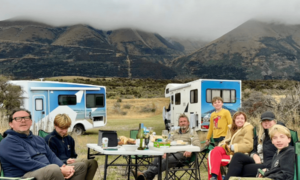In a world where travel has become more than just a luxury but rather an integral part of our lives, there’s one faithful companion that never leaves our side: the suitcase. But have you ever stopped to wonder about the hidden meanings behind this trusty travel buddy? From its size and shape to its color and style, your luggage speaks volumes about who you are as a traveler.
Introduction
When we think of a suitcase, the first thing that comes to mind is packing for a trip or moving to a new place. But have you ever stopped and wondered about the significance behind this everyday object? Why do we use suitcases instead of just carrying our belongings in a backpack or tote bag? What does our choice of luggage say about us?
In this blog post, we will delve deep into the significance and symbolism behind suitcases. From their history to their modern-day meaning, we will explore how suitcases have evolved over time and how they are more than just a mode of transportation for our belongings.
The history of luggage and its evolution over time
The history of luggage dates back to ancient times, when humans began to travel for trade, exploration, and conquest. Initially, people used baskets and sacks made from animal hides or plant fibers to carry their belongings. As civilization progressed, so did the need for more sophisticated forms of luggage.
During the Middle Ages, leather trunks were introduced as a means of transporting goods and clothes on long journeys. These trunks were heavy and bulky, making it difficult for travelers to move them around easily. However, they provided better protection for fragile items compared to earlier forms of luggage.
In the 19th century, with the rise of transportation methods such as trains and steamships, there was a greater demand for lightweight and portable luggage. This led to the invention of suitcases made from canvas or linen materials that could be stacked on top of each other in train compartments or ships’ cabins. The iconic style of these suitcases featured a hard shell exterior with brass locks and buckles.
The industrial revolution in the late 19th century brought about significant changes in luggage design. With mass production techniques being introduced in manufacturing processes, suitcases became cheaper and more accessible to the general public.
The psychology behind packing and traveling with luggage
Packing and traveling with luggage may seem like a mundane task, but it actually involves a lot of psychology. Our choice of luggage and the way we pack it can reveal a lot about our personality, priorities, and mindset.
One reason why packing can be stressful is because it requires decision-making. We have to choose what items to bring and what to leave behind. This process can reveal our preferences and values. For example, someone who packs light may value simplicity and practicality, while someone who packs many items may prioritize being prepared for any situation.
The type of luggage we choose also reflects our personalities. A person with a sleek, modern suitcase may appear organized and efficient, while someone with a colorful backpack may be seen as adventurous or spontaneous. Moreover, the size of our luggage can also indicate how much control we want to have over our travels. Those who prefer larger suitcases tend to be more structured and in control, whereas those who opt for smaller bags may enjoy spontaneity and flexibility.
Another aspect of the psychology behind packing is attachment. We often pack items that hold sentimental value or remind us of people or places we love. These items provide comfort during travel, especially if we are going somewhere unfamiliar or far from home.
Practical tips for choosing the right luggage for your needs
When it comes to choosing the right luggage for your travels, there are a few practical tips that can help you make the best decision. These tips will not only ensure that you have the most suitable luggage for your needs but also make traveling much easier and more efficient.
1. Consider the type of trip:
First and foremost, think about the type of trip you will be taking. Will you be traveling for business or leisure? Will you need to pack formal or casual clothing? This will determine the size and style of luggage that would be most appropriate.
2. Look at size and weight restrictions:
Before purchasing any luggage, check the size and weight restrictions of the airlines, trains, or buses that you will be using during your trip. This will help you avoid extra baggage fees and make sure that your luggage is within acceptable limits for easy transportation.
3. Evaluate durability:
Luggage goes through a lot during travel, from being loaded onto planes to being tossed around by baggage handlers. It is essential to choose a suitcase that is durable enough to withstand this wear and tear. Hardshell suitcases tend to be more robust than soft ones, but they are also heavier.
4. Think about storage options:
Consider how many compartments or pockets your desired luggage has for organizing your items efficiently. Some suitcases come with separate compartments for shoes or toiletries, while others have built-in compression straps to keep clothes in place.
5. Check the wheels:
One of the easiest ways to transport heavy luggage is by using wheeled suitcases. However, not all wheels are created equal; some may spin 360 degrees while others only move forward and backward. Test out different types of wheels before making a purchase to find what works best for you.
6. Consider additional features:
Nowadays, many suitcases come with additional features, such as built-in USB ports for charging devices or combination locks for added security. While these features may seem unnecessary, they can be convenient and provide peace of mind during your travels.
7. Stick to a budget:
Luggage comes in various price ranges, so it is crucial to set a budget before starting your search. Do some research and compare prices from different brands to find the best-quality luggage within your budget.
Personal anecdotes and experiences with luggage
Personal anecdotes and experiences with luggage can often reveal a lot about a person’s travel habits, personality, and even their life story. As someone who has traveled extensively, I have had my fair share of interesting encounters with luggage. From lost bags to sentimental suitcases, each experience has taught me something new about the significance behind our choice of luggage.
One particularly memorable experience was when I traveled to Europe for the first time. I had meticulously packed everything in my brand new designer suitcase, feeling confident that it would withstand any journey. However, upon arriving at my destination, I discovered that the handle had completely snapped off during transit. This incident not only left me frustrated but also made me realize the importance of investing in durable and reliable luggage.
On another trip, I found myself struggling through cobblestone streets with an oversized duffel bag filled to the brim with souvenirs and gifts for loved ones back home. As much as I loved collecting items from different countries, this experience taught me the value of packing light and leaving room for potential purchases along the way.
But perhaps one of the most meaningful experiences with luggage was when I inherited my grandmother’s vintage trunk after she passed away. This beautiful piece had weathered many travels throughout her lifetime and was now being passed down to me as a symbol of her adventurous spirit. Each scratch and sticker on its surface told a story of its own, from exotic destinations to treasured memories shared with loved ones. It made me realize that our choice of luggage can hold sentimental value far beyond its practical purpose.
Conclusion:
Luggage holds a deeper meaning than just being a functional item for travel. It represents our journey, helps us make informed decisions, adds sentimental value, and promotes mindfulness towards responsible traveling. By understanding the significance behind our suitcases, we can have a stress-free and meaningful travel experience every time.



































